Gardening has been an integral part of American culture for centuries, and the wisdom of experienced gardeners has been passed down through the pages of iconic gardening books. These books offer valuable insights, techniques, and inspiration for both novice and seasoned gardeners. Here, we explore a selection of iconic American gardening books that have made a lasting impact on horticulture and the joy of gardening:
“A Garden from a Hundred Packets of Seeds” by James Fenton (2005)
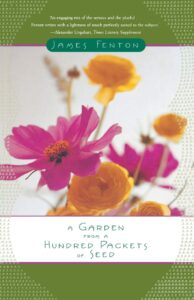
In the world of gardening literature, James Fenton’s “A Garden from a Hundred Packets of Seeds” stands as a delightful and enchanting work that combines the art of storytelling with the practicalities of gardening. This book is a treasure trove of horticultural wisdom, personal experiences, and the sheer joy of growing plants from seeds.
The Author: James Fenton, a celebrated English poet, essayist, and gardening enthusiast, brings his lyrical prose and poetic sensibilities to the world of gardening. In “A Garden from a Hundred Packets of Seeds,” Fenton takes readers on a captivating journey through his own gardening adventures.
The Essence of the Book: This book is a celebration of the potential and beauty that can emerge from the simple act of sowing seeds. Fenton’s garden is his canvas, and the seeds are his paints, creating a vivid tapestry of colors, scents, and textures. He encapsulates the essence of gardening as an art form and a deeply personal journey.
Key Highlights
- The Beauty of Starting from Scratch: Fenton extols the virtues of starting a garden from seeds, capturing the wonder of seeing life emerge from small, dry packets. He shares the anticipation, surprise, and satisfaction that come with nurturing tiny seeds into robust plants.
- Garden as a Metaphor: Fenton’s garden is not only a physical space but a metaphor for life’s possibilities. He weaves philosophical and literary references into his narrative, making the garden a reflection of human existence and the beauty of the unknown.
- Variety and Experimentation: The author embraces variety in his garden, experimenting with a wide array of plants. He encourages gardeners to explore different species, colors, and scents, reflecting the rich diversity that nature offers.
- Challenges and Triumphs: Fenton doesn’t shy away from the challenges of gardening. He shares the failures, disappointments, and surprises that come with tending a garden, making the journey relatable to fellow gardeners.
- Seasonal Reflections: The book is structured around the seasons, allowing readers to experience the garden’s transformation throughout the year. Each chapter reflects the changing landscape, from the first shoots of spring to the dormancy of winter.
Why It’s Iconic
“A Garden from a Hundred Packets of Seeds” has achieved iconic status in the world of gardening literature for several reasons:
- Unique Perspective: Fenton’s blend of poetic insight and horticultural expertise offers a unique perspective on gardening, making the book distinct from traditional gardening guides.
- Embracing Imperfection: The book celebrates the imperfections and uncertainties of gardening, resonating with readers who may not have a perfectly manicured garden but find beauty in the process.
- Inspiration: Fenton’s passion for gardening and storytelling inspires readers to embark on their gardening journeys, regardless of their experience level.
- A Love Letter to Seeds: The book serves as a love letter to the transformative power of seeds and the remarkable potential they hold.
In “A Garden from a Hundred Packets of Seeds,” James Fenton cultivates a literary and horticultural masterpiece that captures the magic, possibilities, and beauty of gardening. Whether you’re an experienced gardener or someone contemplating their first garden, this book invites you to explore the art of sowing seeds and the wonder of watching life unfold in your own garden.
“Rodale’s Basic Organic Gardening” by Deborah L. Martin (2014)
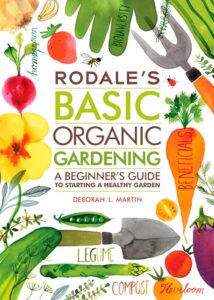
Organic gardening has gained significant popularity in recent years, and for those seeking a comprehensive resource on this sustainable and eco-friendly approach to growing plants, “Rodale’s Basic Organic Gardening” by Deborah L. Martin is an indispensable guide. This book provides both beginners and experienced gardeners with a wealth of knowledge on organic gardening practices, offering valuable insights into creating healthy and productive gardens without the use of synthetic chemicals.
The Author: Deborah L. Martin is a seasoned horticulturist, writer, and editor with a passion for organic gardening. Her wealth of experience and deep understanding of sustainable gardening practices make her an ideal author for this informative guide.
Key Highlights
- Foundations of Organic Gardening: “Rodale’s Basic Organic Gardening” lays a solid foundation for understanding the core principles of organic gardening. Martin discusses the importance of soil health, composting, and the role of organic matter in fostering a thriving garden ecosystem.
- Organic Pest and Disease Management: The book offers practical strategies for managing pests and diseases in an organic garden. It emphasizes preventive methods, companion planting, and natural remedies to maintain a healthy garden.
- Plant Selection and Care: Readers gain insights into selecting and caring for a wide variety of plants, from vegetables and herbs to flowers and trees. Martin offers advice on crop rotation, succession planting, and plant-specific care tips.
- Composting and Soil Improvement: The book places a strong focus on the significance of composting and soil enrichment. It provides clear guidance on creating nutrient-rich compost and using it to improve soil structure and fertility.
- Organic Techniques for Specific Plants: Whether you’re interested in growing tomatoes, cucumbers, roses, or any other plant, the book includes specific instructions and tips for organic cultivation.
- Environmental Stewardship: The book underscores the ecological and environmental benefits of organic gardening. By avoiding synthetic chemicals and embracing natural solutions, readers contribute to a healthier planet.
- Garden Design: “Rodale’s Basic Organic Gardening” also covers the aesthetic aspects of gardening. It provides insights into garden design, layout, and creating visually appealing landscapes while adhering to organic principles.
Why It’s Iconic
- Comprehensive Resource: “Rodale’s Basic Organic Gardening” is a comprehensive guide that covers every aspect of organic gardening, making it an invaluable resource for gardeners of all levels.
- Reliable Authorship: Deborah L. Martin’s expertise and authority in organic gardening add credibility to the book, making it a trusted source for organic gardening practices.
- Sustainable Gardening Focus: The book’s commitment to sustainable and environmentally friendly gardening aligns with the growing global interest in eco-conscious and chemical-free gardening.
- Accessible Language: Martin’s writing is approachable and user-friendly, making complex topics in organic gardening easy to understand for readers of all backgrounds.
This iconic book is not only a practical guide but also an inspiring call to embrace organic gardening as a way to connect with the natural world, protect the environment, and grow healthy and delicious produce. “Rodale’s Basic Organic Gardening” by Deborah L. Martin is a must-read for those looking to embark on a sustainable gardening journey or enhance their existing organic gardening practices.
“Planting: A New Perspective” by Piet Oudolf and Noel Kingsbury (2013)
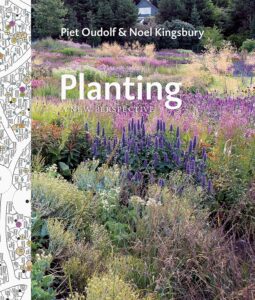
“Planting: A New Perspective” is not just a gardening book; it’s a transformational exploration of the art of planting design. This iconic work, co-authored by Piet Oudolf and Noel Kingsbury, challenges conventional garden design with a naturalistic approach that has resonated with gardeners, landscape designers, and horticulturists around the world.
The Authors: Piet Oudolf is a Dutch garden designer renowned for his work in public gardens and private landscapes. Noel Kingsbury, a prolific author and horticulturist, shares Oudolf’s vision for a more ecologically attuned and emotionally engaging approach to planting design.
Key Highlights
- Naturalistic Planting Design: “Planting: A New Perspective” introduces readers to a style of planting design that embraces a more natural and harmonious approach. Oudolf and Kingsbury challenge the rigid geometry of traditional gardens, advocating for designs inspired by the dynamic and ever-changing beauty of nature.
- The Planting Matrix: The authors introduce the concept of a “planting matrix,” a dynamic system where plants are chosen not only for their visual appeal but also for their ecological contributions, including support for pollinators, birds, and other wildlife.
- Seasonal Interest: The book encourages gardeners to appreciate the year-round beauty of their gardens. It emphasizes the importance of selecting plants that offer visual interest in all seasons, from spring blooms to winter structure.
- Ecological Considerations: “Planting: A New Perspective” promotes biodiversity and ecological awareness. The authors encourage gardeners to think beyond aesthetics and consider the environmental and habitat value of their plant choices.
- Texture and Form: The book explores the role of texture, form, and structure in garden design. It challenges readers to create gardens with a strong sense of place and an emotional connection to the natural world.
- Case Studies: “Planting: A New Perspective” includes case studies of Oudolf’s own garden designs, offering a real-world glimpse into the practical application of the naturalistic planting matrix.
Why It’s Iconic
- Paradigm Shift: This book represents a paradigm shift in garden design. It challenges conventional ideas about garden aesthetics and encourages gardeners to embrace the beauty and dynamism of wilder, more ecologically attuned landscapes.
- International Impact: Piet Oudolf’s work, as showcased in this book, has had a profound influence on garden design worldwide. His gardens, such as the High Line in New York City, have become iconic examples of naturalistic planting design.
- Emotional and Ecological Connection: “Planting: A New Perspective” goes beyond the visual appeal of gardens and speaks to the emotional and ecological connection between humans and the natural world.
- Enduring Relevance: The book’s message continues to be relevant as interest in sustainable and environmentally conscious gardening practices grows. It encourages gardeners to think more deeply about their role in supporting local ecosystems.
“Planting: A New Perspective” is a groundbreaking work that challenges conventional notions of garden design and invites gardeners to embark on a more profound and ecologically informed journey. Its message of creating gardens that are not only visually stunning but also beneficial to the environment resonates with those who seek a deeper connection with nature through their gardens.
“The Well-Tempered Garden” by Christopher Lloyd (1970)
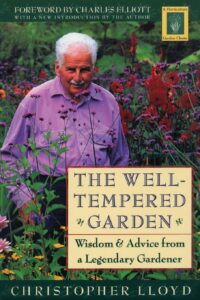
Published in 1970, “The Well-Tempered Garden” by Christopher Lloyd is a timeless and beloved classic in the world of gardening literature. Known for his bold and unconventional approach to gardening, Lloyd shares his experiences, wisdom, and unapologetic opinions in this iconic book. It has inspired generations of gardeners, offering a refreshing perspective on the art of gardening.
The Author: Christopher Lloyd, a prominent British gardener, writer, and plantsman, is celebrated for his extraordinary garden at Great Dixter in East Sussex, England. His expertise and passion for plants, combined with his candid and often humorous writing style, made him a gardening icon.
Key Highlights
- Personal Insights: “The Well-Tempered Garden” is not a conventional gardening manual but a collection of Lloyd’s personal observations and experiences. His writing style is candid, witty, and engaging, offering a glimpse into his gardening life.
- Garden Philosophy: Lloyd shares his philosophy on gardening, which emphasizes experimentation, challenging the norm, and a willingness to embrace mistakes as valuable learning experiences.
- Plants and Plant Combinations: The book features insights on an array of plants, their characteristics, and how they can be combined to create visually striking and harmonious garden displays.
- Garden Design and Structure: Lloyd explores the architectural aspects of garden design, discussing layout, hedges, borders, and paths. He encourages gardeners to consider both practical and aesthetic aspects in their garden design.
- Seasonal Considerations: The book offers guidance on creating year-round interest in the garden. Lloyd’s garden at Great Dixter is known for its all-season appeal, and he shares tips on how to achieve this.
- Gardening as an Art: Lloyd’s writing reflects his view of gardening as a form of art. He encourages gardeners to approach their gardens as creative expressions of their personalities and passions.
Why It’s Iconic
- Unconventional Approach: Christopher Lloyd’s unconventional and irreverent approach to gardening challenges traditional gardening norms and encourages gardeners to think outside the box.
- Candid and Personal: “The Well-Tempered Garden” is a personal and honest account of Lloyd’s gardening journey, which resonates with readers and gardeners who appreciate authenticity.
- Plant Expertise: The book showcases Lloyd’s profound knowledge of plants and how they can be used to create stunning and dynamic garden displays.
- Enduring Relevance: Despite being written over 50 years ago, the book’s messages about experimentation, embracing failures, and the creative aspect of gardening remain relevant and inspiring to gardeners today.
- Great Dixter Legacy: The book also serves as a tribute to Lloyd’s famous garden at Great Dixter, which continues to be a source of inspiration and pilgrimage for garden enthusiasts.
“The Well-Tempered Garden” is a book that celebrates the art of gardening as a personal and creative journey. Christopher Lloyd’s passion, expertise, and candid writing style make this book an enduring source of inspiration and a must-read for gardeners looking to infuse their gardens with personality, experimentation, and a touch of rebellious spirit.
“The Vegetable Gardener’s Bible” by Edward C. Smith (2000)
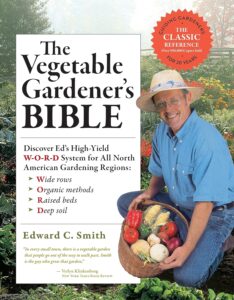 Edward C. Smith’s “The Vegetable Gardener’s Bible” is a gardening classic that has served as an indispensable resource for vegetable gardeners for over two decades. This comprehensive guide equips both beginners and experienced gardeners with the knowledge and techniques needed to grow a bountiful and sustainable vegetable garden.
Edward C. Smith’s “The Vegetable Gardener’s Bible” is a gardening classic that has served as an indispensable resource for vegetable gardeners for over two decades. This comprehensive guide equips both beginners and experienced gardeners with the knowledge and techniques needed to grow a bountiful and sustainable vegetable garden.
The Author: Edward C. Smith is an experienced gardener, author, and speaker with a deep passion for organic and sustainable gardening practices. His expertise and accessible writing style have made him a trusted source of guidance for gardeners worldwide.
Key Highlights
- Organic Gardening Principles: “The Vegetable Gardener’s Bible” emphasizes organic and sustainable gardening methods. Smith’s approach promotes healthy soil, natural pest control, and eco-friendly practices.
- Garden Planning: The book guides readers through the process of planning a vegetable garden, from selecting the right location and soil preparation to designing layouts and crop rotation.
- Planting Techniques: Smith provides valuable insights into sowing seeds, transplanting seedlings, and caring for plants at every stage of growth. He discusses proper spacing, trellising, and the use of raised beds.
- Crop Selection: The book covers a wide variety of vegetables, from the most popular to unique and lesser-known varieties. Each vegetable is described in detail, with advice on planting, care, and harvesting.
- Year-Round Gardening: Smith encourages year-round gardening with tips on extending the growing season through cold frames, row covers, and greenhouse gardening.
- Problem-Solving: The book offers practical solutions to common gardening challenges, including pest and disease management, soil improvement, and dealing with weather-related issues.
- Companion Planting: Smith discusses the benefits of companion planting and offers guidance on which plants work well together to promote healthy growth and deter pests.
Why It’s Iconic
- Comprehensive and Accessible: “The Vegetable Gardener’s Bible” is known for its comprehensive coverage of all aspects of vegetable gardening, making it a valuable resource for both beginners and experienced gardeners.
- Organic Emphasis: The book’s focus on organic and sustainable gardening aligns with the growing interest in environmentally friendly and chemical-free gardening practices.
- Practical Guidance: Edward C. Smith’s practical advice and step-by-step instructions make it easy for readers to apply the principles of successful vegetable gardening.
- Time-Tested Wisdom: Despite being published over two decades ago, the book’s advice remains relevant and valuable, reflecting its enduring status as a gardening classic.
- Abundant Harvests: “The Vegetable Gardener’s Bible” has empowered countless gardeners to enjoy abundant and healthy harvests, making it a beloved and trusted gardening companion.
Whether you’re a novice gardener or a seasoned pro, “The Vegetable Gardener’s Bible” is a book that continues to be cherished for its wealth of knowledge, practical guidance, and commitment to organic and sustainable gardening. It’s a must-have reference for anyone looking to cultivate a productive and rewarding vegetable garden.
“The Wild Garden” by William Robinson (1870)
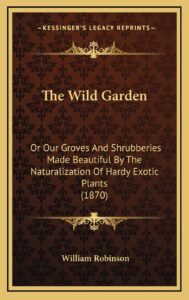 Published in 1870, “The Wild Garden” by William Robinson is a timeless masterpiece that laid the foundation for the naturalistic gardening movement. This book challenged the formal, highly manicured gardens of the Victorian era and championed the beauty of wild and natural landscapes. William Robinson’s pioneering ideas on garden design and plant selection have left an indelible mark on the world of horticulture.
Published in 1870, “The Wild Garden” by William Robinson is a timeless masterpiece that laid the foundation for the naturalistic gardening movement. This book challenged the formal, highly manicured gardens of the Victorian era and championed the beauty of wild and natural landscapes. William Robinson’s pioneering ideas on garden design and plant selection have left an indelible mark on the world of horticulture.
The Author: William Robinson, an Irish horticulturist and writer, was a trailblazer in the realm of gardening and landscape design. His revolutionary ideas and passion for naturalistic gardens led to a profound transformation in garden aesthetics.
Key Highlights
- Naturalistic Garden Design: “The Wild Garden” advocates for a more natural and relaxed approach to garden design. Robinson’s philosophy promotes gardens that mimic the charm and spontaneity of wild landscapes.
- Embracing Wildflowers: The book champions the use of wildflowers in garden design. Robinson encourages gardeners to incorporate native and non-native wildflowers into their landscapes, emphasizing the ecological benefits and beauty they bring.
- Simplicity and Authenticity: Robinson believes in the power of simplicity and authenticity in garden design. He encourages gardeners to create spaces that are a reflection of the natural world, avoiding artificiality and rigid formality.
- Sowing and Self-Seeding: The book discusses the practice of sowing seeds and allowing plants to self-seed. This approach allows for a more dynamic and ever-changing garden landscape.
- Year-Round Interest: Robinson’s emphasis on the importance of year-round interest in the garden encourages gardeners to appreciate the beauty of all seasons.
- Ecological Considerations: “The Wild Garden” underscores the ecological and habitat value of wildflowers and native plants in supporting local wildlife and pollinators.
Why It’s Iconic
- Revolutionary Impact: “The Wild Garden” is an iconic work because it challenged the formal and rigid gardening practices of its time. Robinson’s ideas initiated a transformation in garden design that is still relevant today.
- Naturalistic Aesthetic: The book’s celebration of naturalistic aesthetics aligns with the modern interest in sustainable and ecologically conscious gardening practices.
- Planting Diversity: Robinson’s emphasis on plant diversity and the use of wildflowers and native species has inspired generations of gardeners to create more biodiverse and ecologically beneficial landscapes.
- Enduring Relevance: Despite being published over 150 years ago, the book’s principles of naturalistic gardening remain timeless and continue to inspire gardeners to embrace the beauty of wild and natural landscapes.
- Legacy: William Robinson’s work and influence can be seen in contemporary naturalistic gardens, public parks, and the wider gardening community. His legacy lives on through the principles outlined in “The Wild Garden.”
“The Wild Garden” by William Robinson is not just a historic document; it’s a living testament to the enduring appeal of naturalistic gardening. The book’s emphasis on the beauty and ecological significance of wild landscapes has inspired gardeners worldwide to create more sustainable, biodiverse, and emotionally engaging outdoor spaces.
“Gardening in the South” by Mark Weathington (2018)
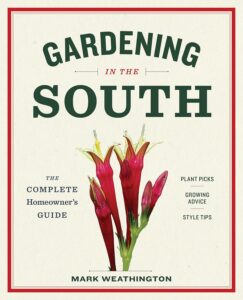 Mark Weathington’s “Gardening in the South” is a valuable and contemporary resource tailored specifically for Southern gardeners. This book addresses the unique challenges and opportunities that gardeners in the Southern United States face, including the region’s diverse climate, soil types, and native flora. It provides expert guidance on how to create and maintain vibrant and successful gardens in this distinct region.
Mark Weathington’s “Gardening in the South” is a valuable and contemporary resource tailored specifically for Southern gardeners. This book addresses the unique challenges and opportunities that gardeners in the Southern United States face, including the region’s diverse climate, soil types, and native flora. It provides expert guidance on how to create and maintain vibrant and successful gardens in this distinct region.
The Author: Mark Weathington, a respected horticulturist and experienced gardener, is the director of the JC Raulston Arboretum at North Carolina State University. His wealth of knowledge and regional expertise makes him an ideal author for this comprehensive guide.
Key Highlights
- Southern Climate and Conditions: “Gardening in the South” explores the wide range of climates in the Southern United States, from the humid Gulf Coast to the mountainous regions. It offers insights into the particular challenges and opportunities each zone presents.
- Plant Selection: The book provides recommendations for a wide variety of plants, including trees, shrubs, perennials, and annuals that thrive in Southern gardens. It discusses native and adapted species that can handle the region’s specific climate and soil conditions.
- Soil and Fertilization: Southern gardeners will find valuable information about their region’s unique soil types, as well as tips on soil improvement, composting, and organic fertilization.
- Pest and Disease Management: The book addresses common pest and disease issues faced by Southern gardeners, offering advice on prevention and control, with an emphasis on eco-friendly solutions.
- Seasonal Gardening: Weathington discusses seasonal gardening tasks, including planting, maintenance, and garden design. Readers will find guidance on creating year-round interest in Southern gardens.
- Gardening Practices: The book covers essential gardening practices such as pruning, mulching, and irrigation, providing region-specific insights.
Why It’s Iconic
- Region-Specific Expertise: “Gardening in the South” fills a significant gap by offering advice tailored to the unique conditions of Southern gardens, including climate, soil, and native flora.
- Plant Recommendations: The book provides plant recommendations that are well-suited to the Southern climate, helping gardeners make informed choices for their landscapes.
- Problem-Solving: Mark Weathington addresses common gardening challenges specific to the region, offering practical solutions for pest, disease, and soil-related issues.
- Contemporary Reference: Published in 2018, the book offers up-to-date information and recommendations, making it a relevant and trusted resource for Southern gardeners.
- Local Horticultural Authority: Mark Weathington’s role as the director of the JC Raulston Arboretum gives him valuable insights into the horticultural needs and practices of the Southern region.
“Gardening in the South” by Mark Weathington is a must-read for anyone gardening in the Southern United States. It provides expert guidance and practical advice that is tailored to the specific challenges and opportunities of the Southern climate and landscape, making it an indispensable resource for gardeners in the region.


